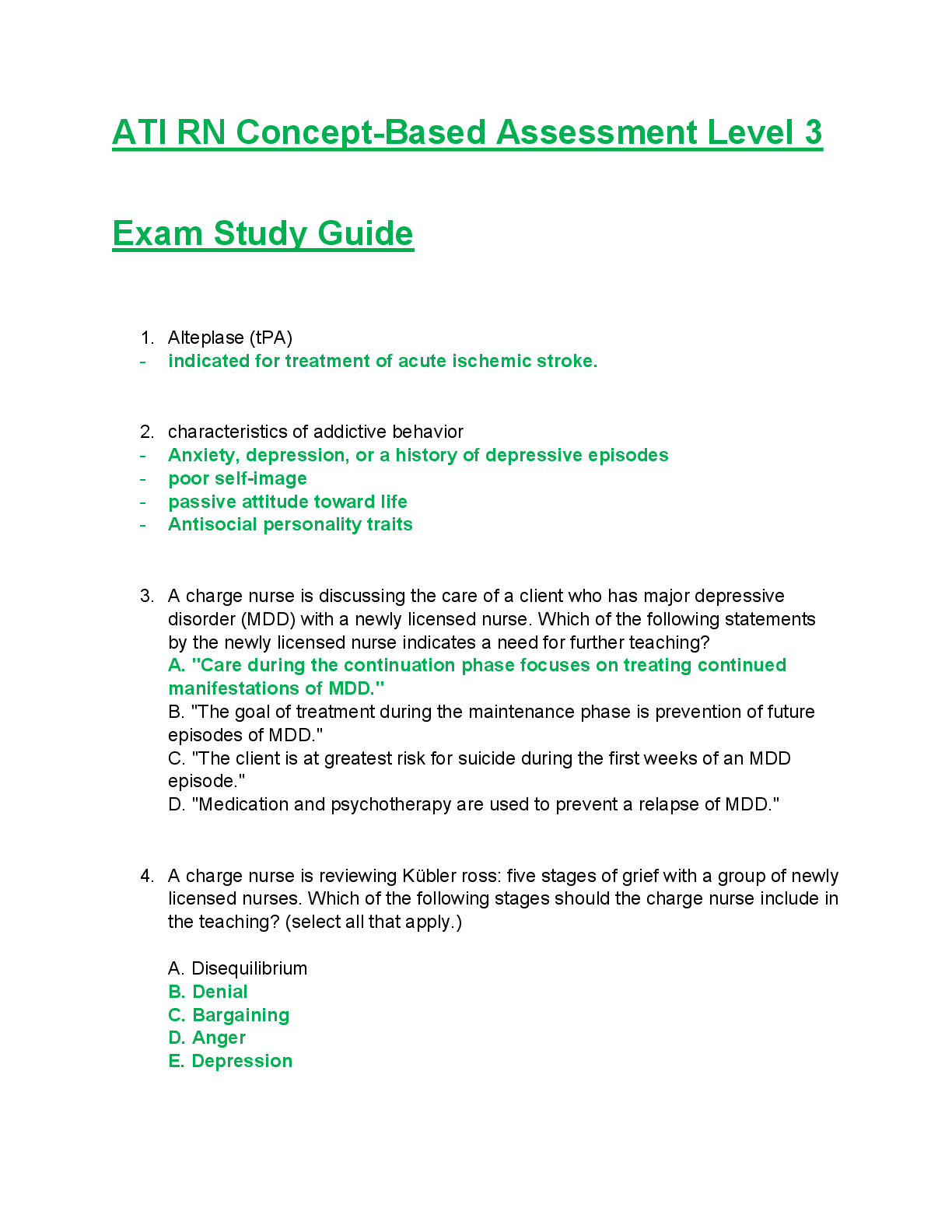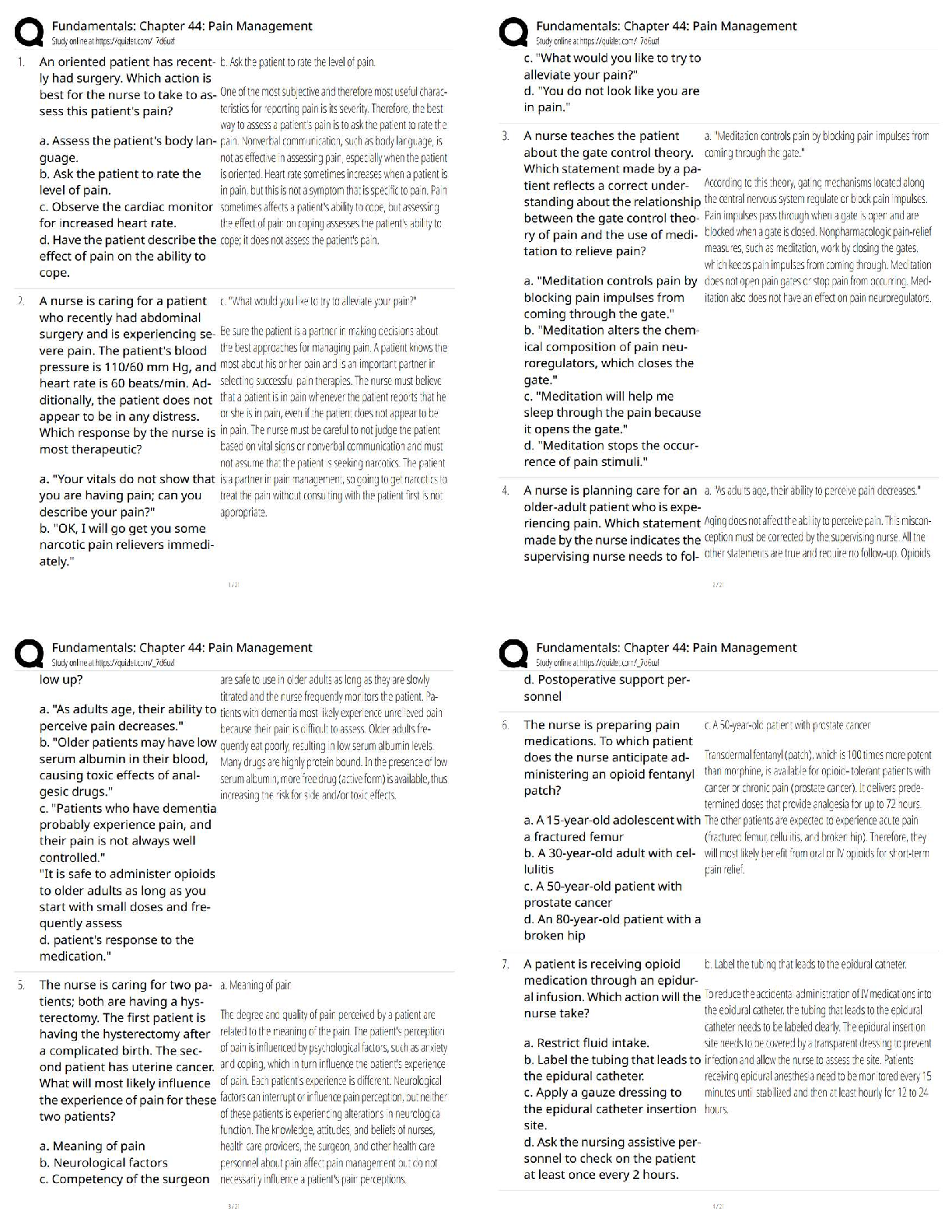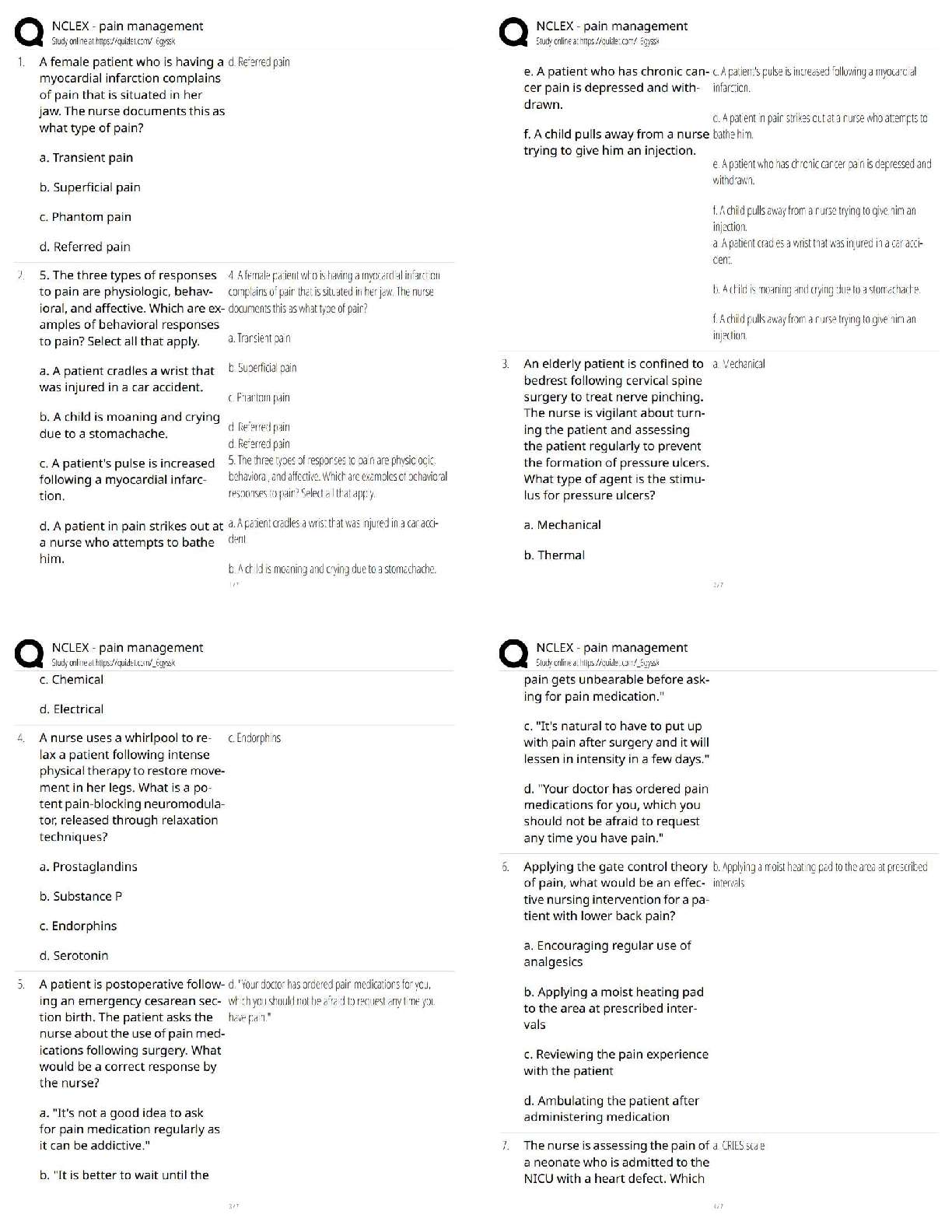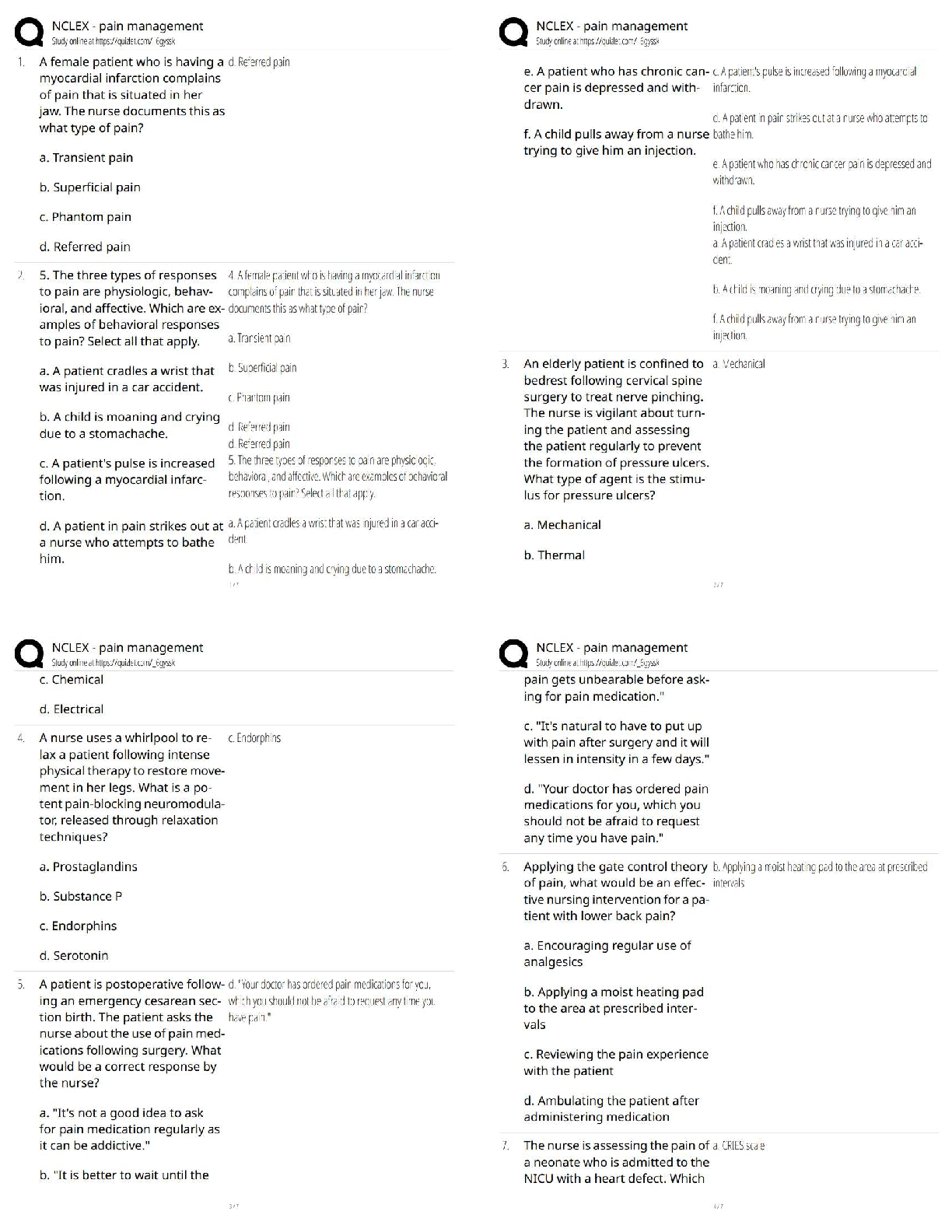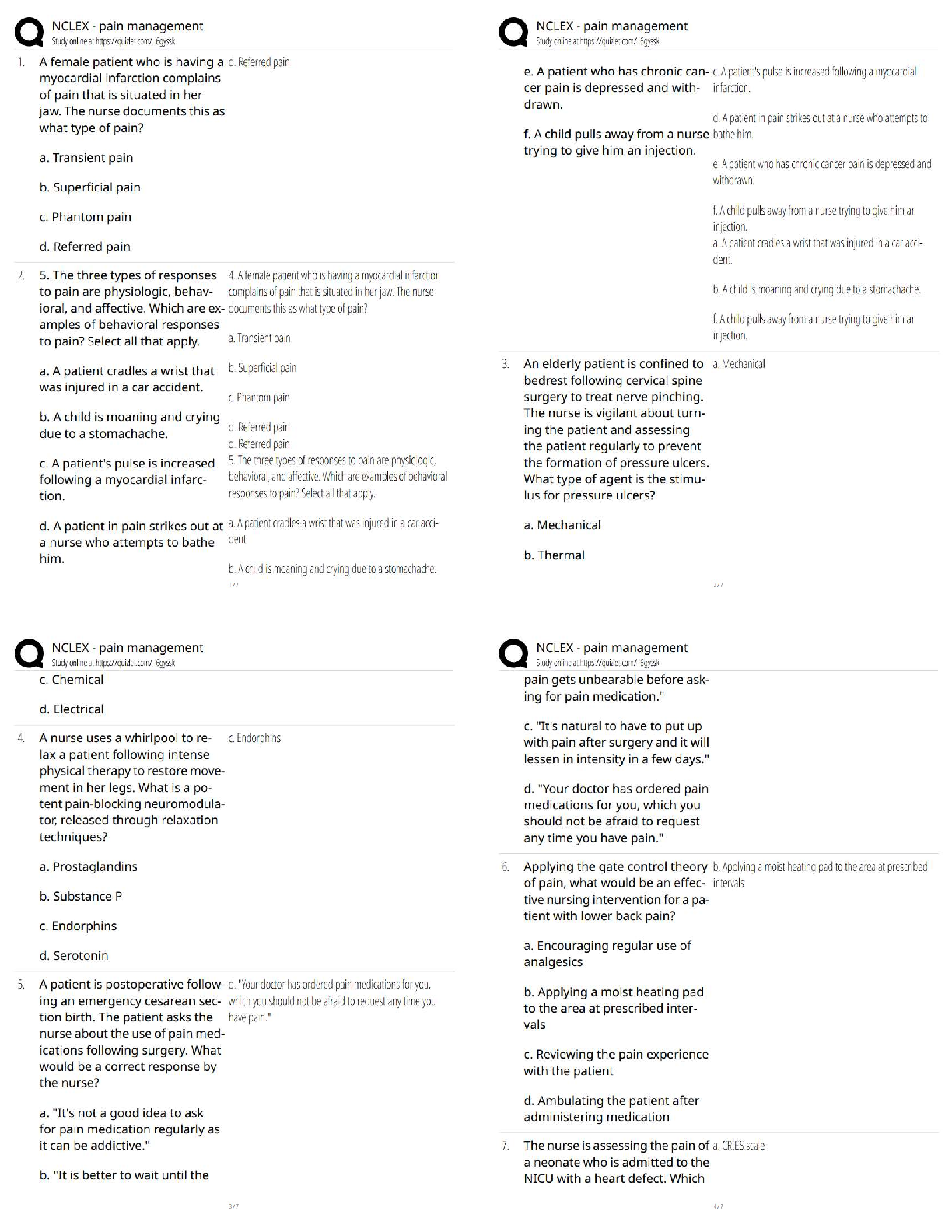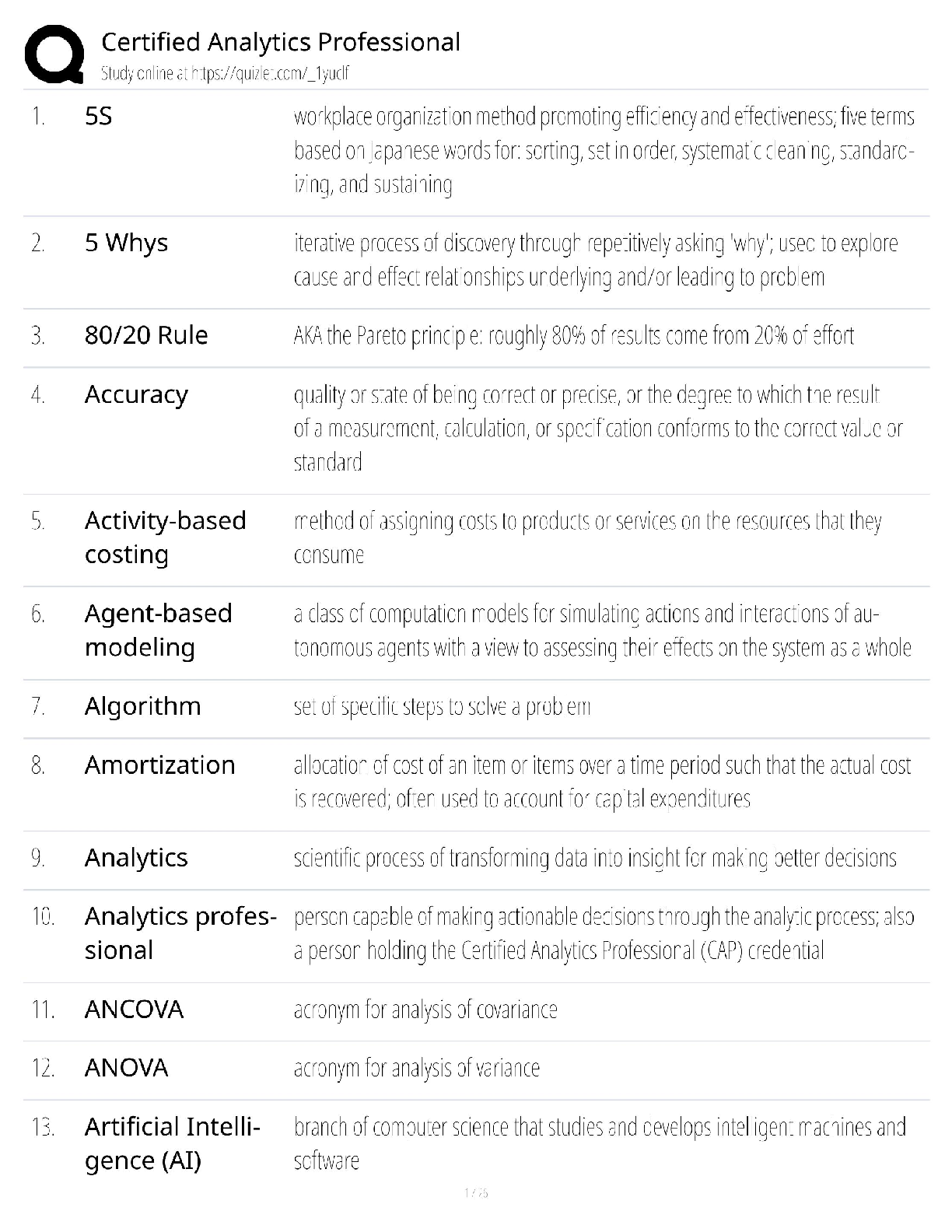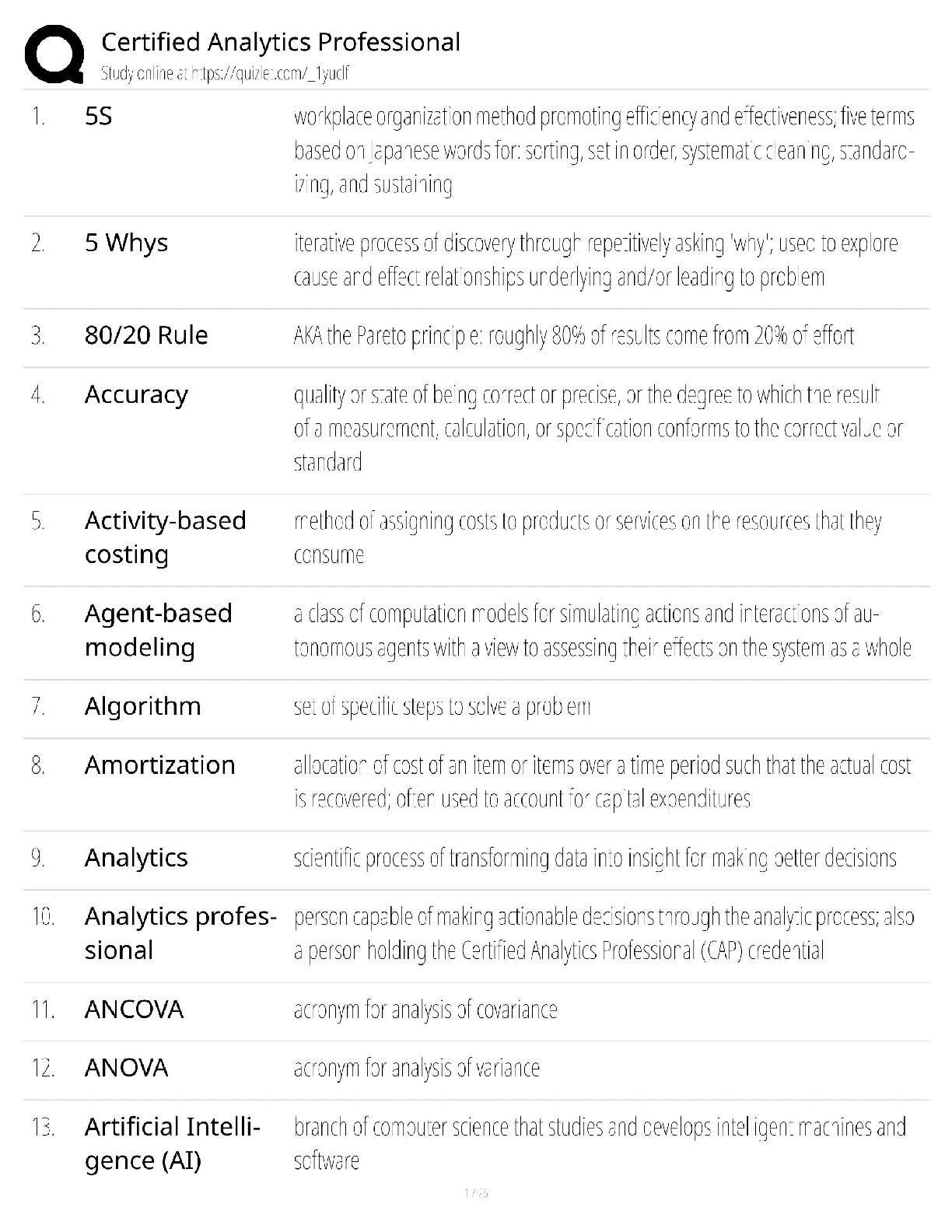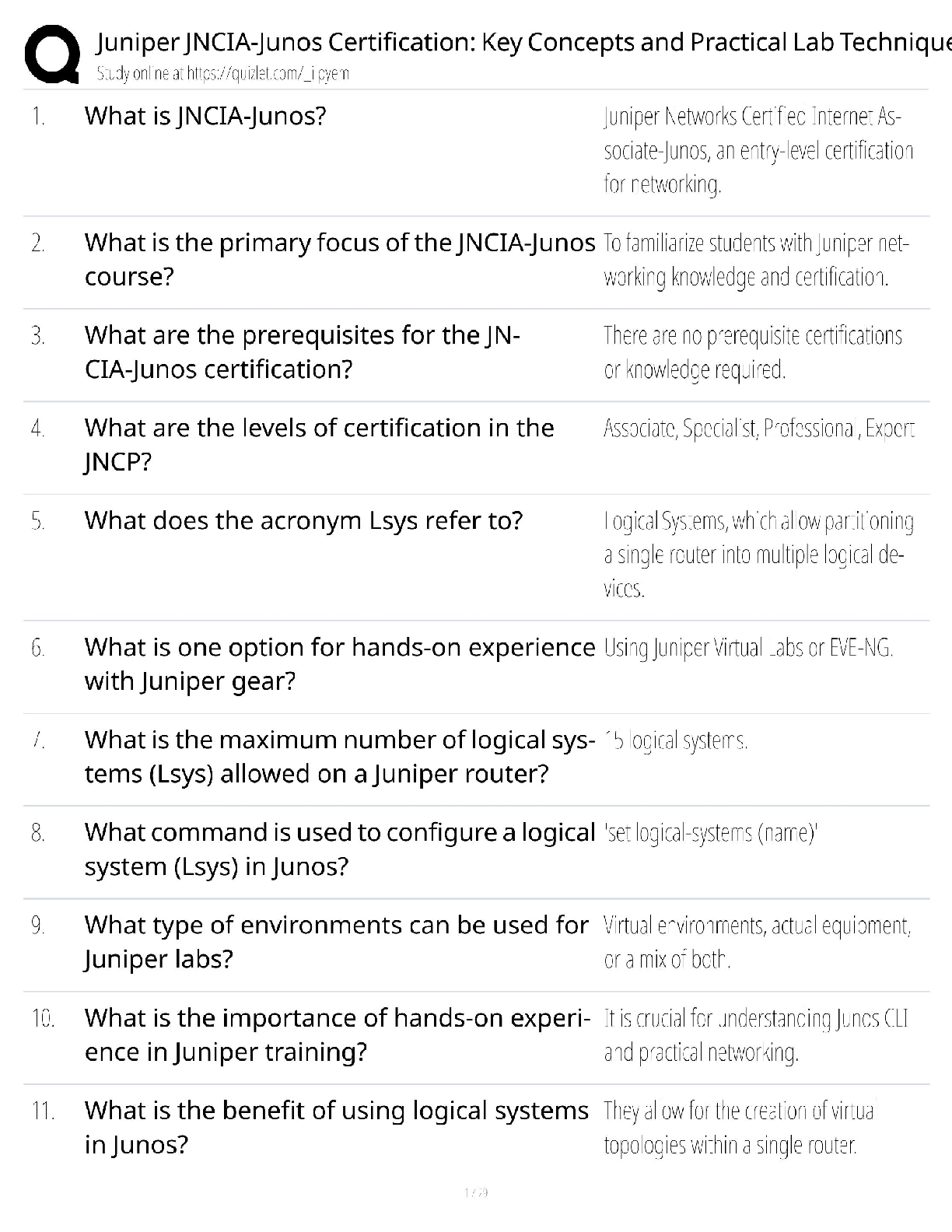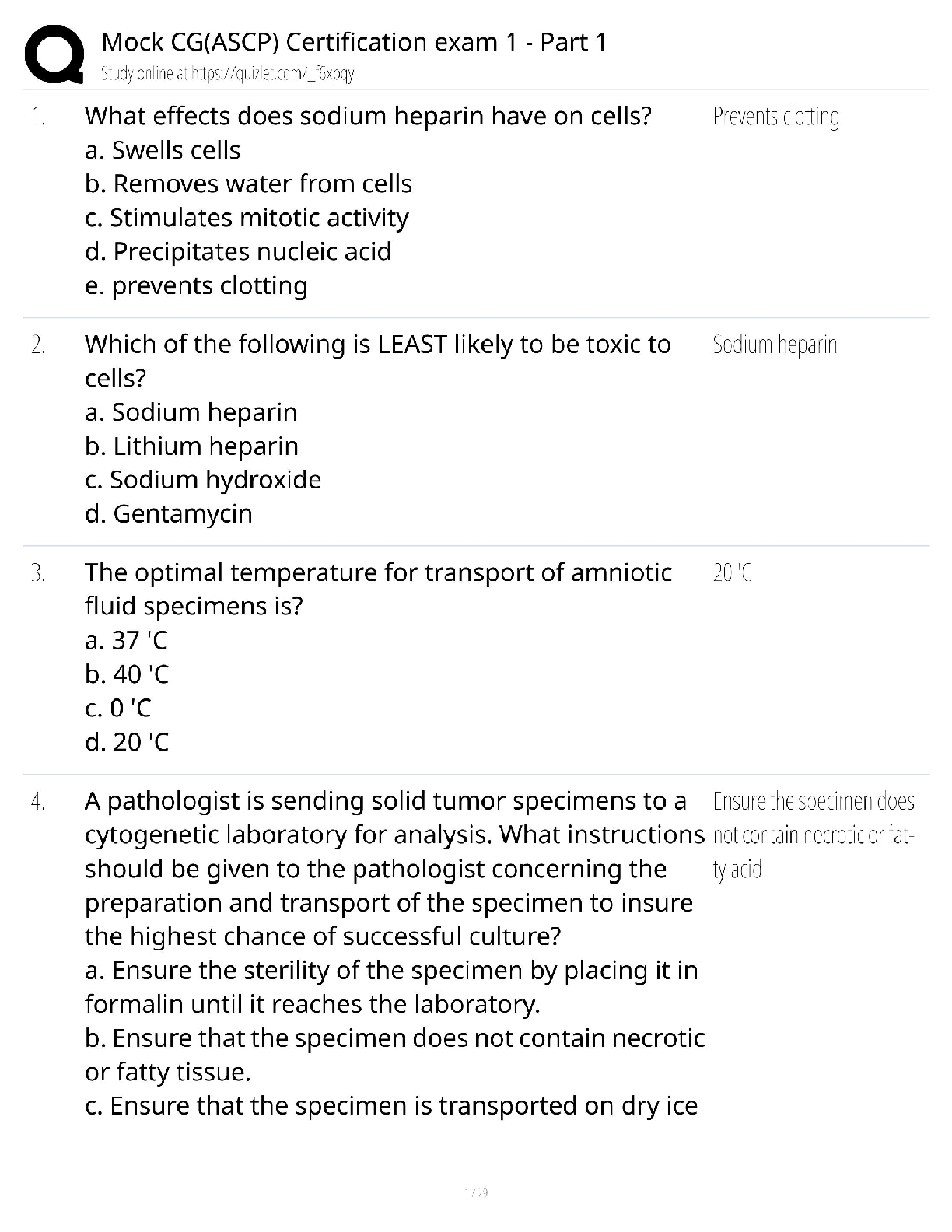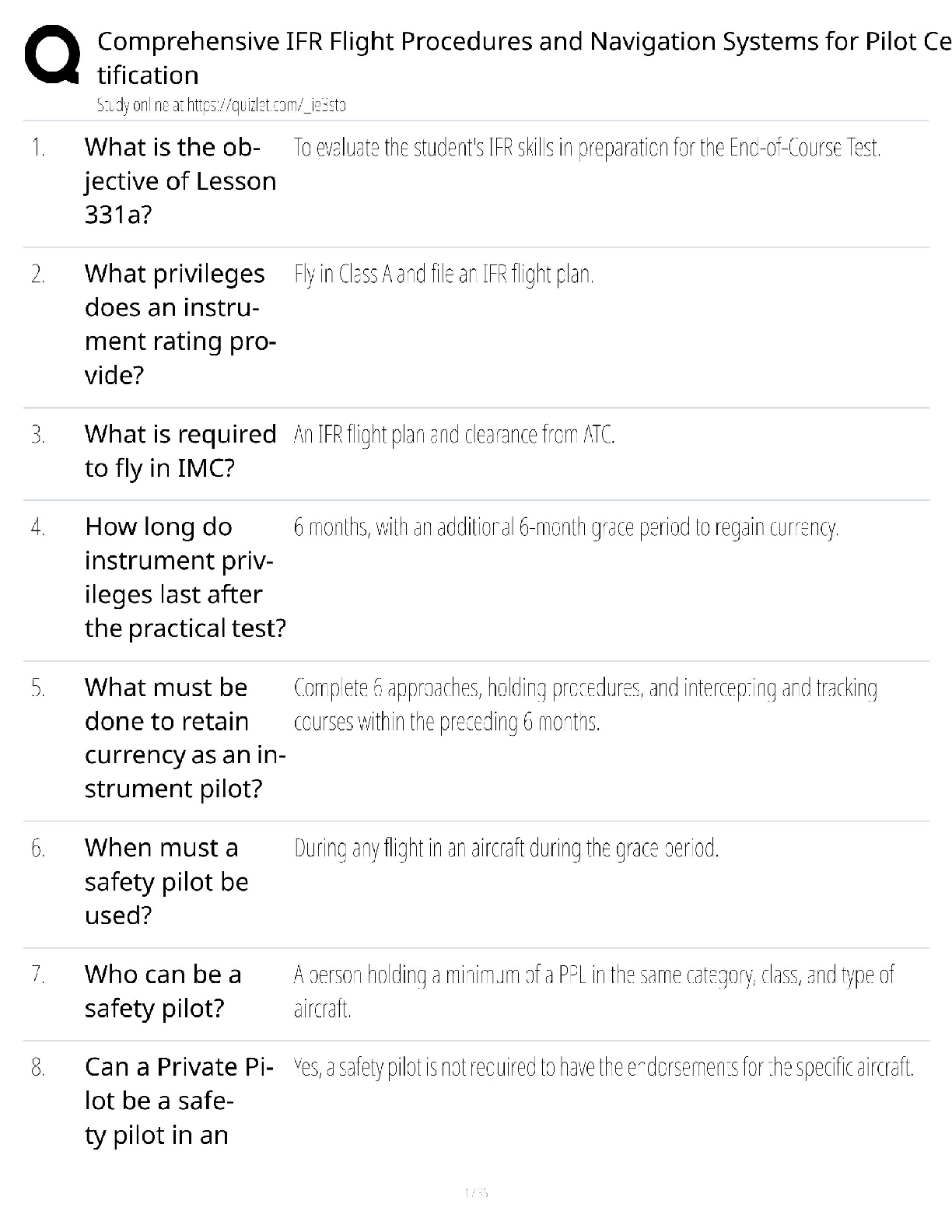*NURSING > QUESTIONS & ANSWERS > APEA PRACTICE 100% Correct (Latest Update 2020 / 2021) (All)
APEA PRACTICE 100% Correct (Latest Update 2020 / 2021)
Document Content and Description Below
APEA PRACTICE A newborn infant develops jaundice at 12 hours-of-age. Which of the following causes of hyperbilirubinemia should be suspected? A. Breastfeeding jaundice B. Cephalhematoma C. P ... hysiological hyperbilirubinemia D. ABO incompatibility A 27-year-old female patient with epilepsy is well controlled with phenytoin (Dilantin®). She requests information about contraception. The nurse practitioner should instruct her that: A. the effectiveness of an oral contraceptive may be reduced. B. she should use a very low dose estrogen oral contraceptive. C. she should use another anticonvulsant along with the phenytoin. D. bilateral tubal ligation is recommended. A nurse practitioner is examining a 2 month old infant. What question is most important to ask about the baby? A. "Does the infant have siblings?" B. "Has the umbilical cord stump fallen off yet?" C. "Was the infant full-term at birth?" D. "Has the baby had a PKU test?" What information should patients with diabetes and their families receive about hypoglycemia? A. Hypoglycemia is very rare. B. Hypoglycemia requires professional medical treatment. C. Hypoglycemia is serious, dangerous, and can be fatal if not treated quickly. D. Hypoglycemia occurs only as a result of overdose of insulin. Strabismus is observed in a 13 month old child. The most appropriate action for the nurse practitioner to take is to: A. refer the patient to an ophthalmologist. B. patch the child's affected eye. C. follow the child closely for 2 more months. D. teach the patient and parent eye muscle exercises. Which patient is at highest risk for sudden infant death syndrome (SIDS)? A. A 14 month old infant with sleep apnea. B. A well developed 2 month old infant. C. A 12 month old infant with asthma. D. A 7 month old infant who sleeps in the supine position. Six weeks gestation is confirmed in a 23 year old, moderately overweight, patient. She asks the nurse practitioner, "Should I diet so I won't gain too much baby fat?" The nurse practitioner appropriately responds: A. "It is probably a good idea to lose a few pounds in the first trimester since it will be harder to control weight gain later." B. "A weight gain of approximately 25 pounds is ideal for mother and baby." C. "It doesn't matter how much weight you gain or lose as long as you eat a well-balanced diet." D. "Just try to limit your weight gain as much as you comfortably are able." A 57 year old patient with known diverticulosis presents with fever, leukocytosis, and bright red rectal bleeding. The nurse practitioner's least appropriate action at this time is: A. management of the acute episode with antibiotic therapy. B. achievement of hemostasis and treatment for anemia. C. a clear liquid diet during the acute phase. D. education regarding low fiber diet. The gold standard for cervical cancer screening is: A. vaginal examination. B. the Papanicolaou smear. C. colposcopy. D. serum carcinoembryonic antigen (CEA). Which of the following laboratory tests is useful in the diagnosis of spontaneous abortion? A. Serial quantitative beta-human chorionic gonadotropin levels B. Qualitative plasma estradiol levels C. Plasma dehydroepiandrosterone sulfate (DHEA-S®) levels D. Qualitative plasma human chorionic gonadotropin levels The correct order of physical examination of the abdomen is: A. inspection, palpation, percussion, auscultation. B. inspection, auscultation, percussion, palpation. C. auscultation, inspection, palpation, percussion. D. palpation, percussion, inspection, auscultation. An elderly patient presents with a gray-white ring around the periphery of the iris. This is probably: A. indicative of underlying atherosclerotic disease. B. a normal variant associated with the aging process. C. an emerging cataract. D. iritis or uveitis. The sexual partner of a symptomatic male patient with gonorrhea should be empirically treated: A. if symptoms are present. B. with ceftriaxone (Rocephin®) 250 mg intramuscularly. C. with ceftriaxone and doxycycline (Vibramycin®). D. only if exposed within 2 weeks of diagnosis. What is the confirmatory test for human immunodeficiency virus in a patient over 18 months-of-age? A. Enzyme-linked immunosorbent assay (ELISA) B. CD4 cell count C. Western blot D. Rapid plasma reagin (RPR) The nurse practitioner is evaluating a 35 year old female nurse. She has a history of hospitalization for hepatitis B infection 2 years ago. Her laboratory tests demonstrate positive HBsAg. The nurse practitioner would most likely diagnose: A. chronic hepatitis B infection. B. acute hepatitis B infection. C. recovered hepatitis B infection. D. recent hepatitis B vaccination Considering mortality statistics for the adolescent age group, education targeted toward this group should first focus on: A. sexually transmitted diseases. B. sports safety. C. automobile safety. D. alcohol abuse. To differentiate testicular torsion from epididymitis, the nurse practitioner should order: A. a urinalysis. B. Doppler ultrasound. C. a urine Gram stain. D. a CT scan. Which statement about bronchopulmonary dysplasia (BPD) is FALSE? A. This disease is a sequela of mechanical ventilation in the neonatal period. B. It is characterized by tachypnea, wheezing, and increased respiratory effort. C. Clinical symptoms of BPD usually resolve after the first 6 months of life. D. Exacerbation of BPD is treated with bronchodilators and corticosteroids. Licensure is: A. another term for certification. B. contingent on certification. C. used to establish minimal competence. D. necessary for reimbursement. A 52 year old female has a firm, non-tender, one centimeter mass in the right lower quadrant of her breast. There are no palpable axillary lymph nodes. A mammogram the month before her examination was negative. The most appropriate nurse practitioner action today is to: A. reassure the patient that the mass is benign. B. refer the patient to a surgeon for evaluation. C. schedule an ultrasound of the breast. D. plan a repeat mammogram in 6 months. The nurse practitioner recommends a 24-hour urine for creatinine clearance. Appropriate instructions to the patient are to: A. begin the 24-hour time period and collect the next voided urine. B. empty the bladder and begin the 24-hour time period, then collect the next voided specimen. C. empty the bladder, begin the 24-hour time period at the time of the next voiding and collect that specimen. D. begin the 24-hour time period, discard the next voided urine, then collect the next voided specimen. Which finding below would be unusual in a patient with diabetic retinopathy? A. Papilledema B. Dot and blot hemorrhages C. Microaneurysms D. Cotton wool spots Which of the following drug classes may potentiate hyperkalemia in a patient taking a potassium-sparing diuretic or potassium supplement? A. Thiazide diuretic B. Angiotensin-converting enzyme inhibitor C. Beta-adrenergic blocker D. Calcium channel blocker A 79 year old female presents to a family practice clinic with her adult daughter. Her daughter reports that her mother complained of palpitations today, became weak, fell, and has been confused since. What is an appropriate action by the nurse practitioner? A. Order a CT scan of the patient's head to rule out closed head injury. B. Order an EKG, cardiac enzymes, clotting studies, and metabolic panel. C. Suspect MI or stroke and arrange transportation to the nearest emergency department. D. Order an MRI of the head to assess for stroke and EKG to assess for MI. What is the most accurate comparison to use when evaluating peak expiratory flow rate (PEFR)? A. Predicted range for height B. Personal best C. Predicted range for weight D. Predicted range The nurse practitioner should refer the pregnant patient for ultrasound and amniocentesis when the patient: A. has a history of high risk sexual behavior. B. received a blood transfusion in 1982. C. has a history of a neural tube defect in a previous pregnancy. D. has unsensitized Rh-negative blood. Which of the following indicates need for further evaluation? A. A 7 year old girl with vaginal bleeding B. A 7 year old girl with no true pubic hair C. A 12 year old boy with sparse, slightly pigmented pubic hair D. A 12 year old girl with breast buds When examining a pregnant patient, where should the fundal height be at 22 weeks? A. Slightly above the symphysis pubis B. At the level of the umbilicus C. Midway between the symphysis pubis and umbilicus D. Just below the xiphoid process A 16 year old female is brought to the nurse practitioner by her mother. The mother states that she believes her child is sexually active and wants the nurse practitioner to "talk to her." When counseling an adolescent about sexual activity and contraception, it is NOT appropriate to: A. ask the mother to leave the room for part of the interview. B. encourage condom use even if other contraceptive methods are utilized. C. discuss confidential information with her mother without the patient's permission. D. discuss the adolescent's sexual experience with her privately. A patient on oral contraceptives reports that she has forgotten to take her pill the last 2 days in a row. What should you advise her? 1. Take 2 tablets daily for the next 2 days, then resume the regular schedule. 2. Begin a new compact of tablets starting on the first day of the cycle. 3. Use an additional method of contraception for the rest of the pillpack. 4. Take one tablet, discard the second, and continue as scheduled. A. 1 only B. 1 and 3 C. 2 only D. 4 only Of the following 4 malpractice issues for which an APRN may incur liability, which is the most prevalent cause of action? A. Failure to refer when the APRN skills are exceeded B. Failure of the APRN to adequately diagnose C. Conduct exceeding the APRNs scope of expertise that causes harm. D. Conduct within the APRNs scope of practice which results in death of a patient. Which drug(s) below would be expected to produce the least amount of hypokalemia? A. Furosemide (Lasix) B. Hydrochlorothiazide (HCTZ) and spironolactone (Aldactone) C. Spironolactone (Aldactone) D. Hydrochlorothiazide (HCTZ) A patient presents to the nurse practitioner with complaints of diarrhea and malaise which started at 2:00 am the morning of the visit. After history and examination, the nurse practitioner advises the patient that the problem should be self-limiting. If the diarrhea does not resolve, when should the nurse practitioner advise the patient to return? A. 24 hours B. 48 hours C. 3 days D. 4 days Expected spirometry readings when the patient has chronic emphysema include: A. decreased residual volume (RV). B. increased vital capacity (VC). C. increased forced expiratory volume (FEV-1). D. increased total lung capacity (TLC). Which characteristic below is typical of the murmur associated with aortic stenosis? A. It radiates toward the apex of the heart. B. It is always associated with shortness of breath. C. It is best heard in the aortic listening point. D. It is a diastolic murmur. Which of the following is appropriate to teach a patient who is using a daily nitrate agent for treatment of chronic angina? A. Continuous 24-hour coverage is necessary for maximum protection. B. A daily 12-hour nitrate-free period is important to prevent tolerance. C. A daily 6-hour nitrate-free period is important to prevent tolerance. D. Nitrate-free periods present a potential for developing nitrate intolerance. Which group is considered to be at high risk for the development of testicular tumors? A. Pre-Adolescence B. Late adolescence through early adulthood C. Mid-life, 40 to 60 years-of-age D. 65 years-of-age and older A patient reports to the nurse practitioner that he was diagnosed with hepatitis B one year ago and has not seen a health care provider since then. What information should this patient be given? A. Hepatitis B is enterically transmitted and does not cause chronic disease. B. About 10% of affected persons become carriers, and are at increased risk for hepatocellular carcinoma. C. Hepatitis B vaccine is recommended to prevent the damaging effects of chronic infection. D. There is no known treatment that will normalize liver functions and improve liver histology. The anatomical site currently believed to be the best location for subcutaneous insulin administration is the: A. buttocks. B. thigh. C. abdomen. D. arm. All of the following interventions with pediatric patients are appropriate EXCEPT: A. Allow a parent-figure to remain with the patient during unpleasant or painful procedures. B. Prepare the patient before treatments and procedures with explanations, demonstrations, or forms of play to reduce stress and fear. C. Console the patient following unpleasant or painful interventions. D. Pre-medicate the patient prior to all painful interventions. Which patient would NOT be considered at high risk for development of tuberculosis infection? A. A patient with cancer B. A prison inmate C. An HIV-infected patient D. A homeless person The nurse practitioner is caring for a 19 year old female college student with iron deficiency anemia secondary to heavy menstrual bleeding. An appropriate initial treatment for this patient is: A. intramuscular iron dextran. B. a daily oral multivitamin with iron. C. oral ferrous sulfate. D. increased intake of dietary iron. The following are all important tests of visual acuity in infants and children up to 3 years-of-age EXCEPT: A. the Hirschberg test. B. the red reflex. C. corneal and pupillary reflexes. D. tracking of visual stimuli. Which of the following tests is(are) used for diagnosis of cystic fibrosis? A. Serum amylase B. Fecal fat excretion C. Pulmonary function studies D. Sweat test A patient with a past history of documented coronary arterial blockage less than 70% complains of chest pain several times per day (while at rest) which is relieved with nitroglycerin. What is the most appropriate initial action for the nurse practitioner? A. Refer to a cardiologist as soon as possible. B. Prescribe long-acting nitroglycerin. C. Order a treadmill stress test. D. Prescribe an ACE inhibitor and re-evaluate in 24 to 48 hours. When counseling a woman who is breastfeeding her 6 month old infant, the nurse practitioner should recommend a caloric intake over her pre-pregnancy requirements of: A. 200 kcal/day. B. 500 kcal/day. C. 900 kcal/day. D. 1000 kcal/day. What is the most appropriate nurse practitioner intervention for a 2 month old febrile infant who appears ill but has no evidence of specific infection upon examination? A. Prescribe oral broad spectrum antimicrobial therapy and recommend acetaminophen as needed. B. Hospitalization, and blood, urine and spinal fluid cultures, followed by antimicrobial therapy. C. Recommend that the parent obtain an appointment with a pediatrician. D. Instruct the parent on the signs and symptoms of serious illness and recomment acetaminophen for fever. Which of the following drugs classes would be most effective in decreasing elevated triglyceride levels (650mg/dL)? A. Bile acid sequestrants B. Nicotinic acid C. Fibrates D. Statins The type of assessment found to be most effective when screening for domestic violence is: A. routine questioning about abuse. B. a written self-report. C. reflection as part of the interview. D. careful physical examination. A 48 year old female presents to the clinic where she is examined by a nurse practitioner. She is thought to have acute cholecystitis. Of the following choices, what is the LEAST likely differential diagnosis? A. Gastroesophageal reflux (GER) B. Angina secondary to ischemic heart disease C. Peptic ulcer disease (PUD) D. Chest wall syndrome What information should a 42 year old patient with newly diagnosed diabetes receive about exercise? A. Buy a good walking shoe with support and a flexible sole. B. Exercise at least 5 days per week. C. Snack before exercise. D. Do not exercise if your blood sugar is greater than 180 mg/dL. A father brings in his 4 year old child who sustained a dog bite to his forearm one hour earlier. The two wounds are each 0.5 cm and appear as a deep puncture wounds. After exploration, debridement, and cleansing, the most appropriate intervention is to: A. suture the wounds. B. apply a topical antibiotic and apply an occlusive dressing without suturing. C. apply a topical antibiotic and leave the wounds uncovered. D. suture the wounds, instruct the father to keep the sites clean and uncovered, and prescribe an oral antibiotic An example of an indirect role of the nurse practitioner is: A. response to illness and assessment of health status and health risks. B. educator, administrator, or researcher, influencing the delivery of direct care. C. diagnosing actual or potential health problems based on analysis of the data collected. D. evaluating the effectiveness of an intervention with the client. The initial management of an adult with hypertension should include: A. evaluation for underlying causes. B. initiation of a thiazide diuretic. C. initiation of a low sodium diet. D. discussion of a low cholesterol diet with the patient. A 3 year old female with a palpable right upper quadrant abdominal mass, anemia, and fever is being evaluated for Wilms' tumor. Which of the following diagnostic tests would be most useful? A. Intravenous pyelogram (IVP) B. Flat and erect x-ray of the abdomen C. Abdominal ultrasound D. Voiding cystourethrogram (VCU) The nurse practitioner receives a call from a 23-year-old patient who is 10 weeks pregnant. She reports that a few days after spending the day baby-sitting a friend's toddler, the toddler develops a rash. The nurse practitioner would be LEAST concerned if the patient was exposed to: A. meningitis. B. scarlet fever (scarlatina). C. hepatitis A. D. varicella. Which of the following medications is indicated for primary prevention of febrile seizures? A. phenobarbital B. acetaminophen (Tylenol) C. aspirin D. phenytoin (Dilantin) Which of the following medication classes is considered first line therapy for patients who have heart failure (HF)? A. ACE inhibitors B. Beta-blockers C. Calcium channel blockers D. Direct vasodilators Salmeterol (Serevent®) in combination with an inhaled steroid is prescribed for a patient with moderate persistent asthma. What is the most important teaching point about salmeterol? A. It is not effective during an acute asthma attack. B. It may take 2 to 3 weeks to begin working. C. This drug works within 10 minutes. D. This drug may be used by patients 6 years and older. newborn with cyanosis secondary to a cardiac anomale probably has: A. Tetralogy of Fallot B. Aortic stenosis C. Pulmonic regurgitation D. Ventricular septal defect (VSD) Standards of practice are: A. treatment protocols or guidelines. B. a means to identify providers who can be reimbursed for services. C. a process by which a state board of nursing grants individuals permission to engage in practice. D. minimum levels of acceptable performance. When a patient presents with symptoms of acute gallbladder disease, what is the appropriate nurse practitioner action? A. Order abdominal x-rays. B. Order abdominal ultrasound. C. Refer the patient to a surgeon for evaluation. D. Prescribe a second-generation cephalosporin. common finding associated with temporal arteritis is: A. severe headache. B. facial nerve paresis or paralysis. C. paresthesia. D. macular degeneration. Which of the following is the best response to a woman who has just admitted she is a victim of spousal abuse? A. "What was it you did to make him angry?" B. "You must seek refuge immediately." C. "I am concerned about your safety." D. "I am going to call a shelter for you." A 64 year old female has sudden onset of right eye pain, blurred vision, and dilated pupil. The most likely diagnosis is acute: A. open-angle glaucoma. B. angle-closure glaucoma. C. retinal detachment. D. uveitis. Untreated infection with human papilloma virus (HPV-16) increases the female's risk for: A. pelvic inflammatory disease. B. ovarian cancer. C. infertility D. cervical cancer. According to the JNC 8 guidelines, hypertension in a 40 year old can be diagnosed when blood pressure exceeds: A. 150/100 B. 140/90 C. 130/90 D. 125/85 An 8 year old female has been brought to the nurse practitioner on 5 occasions in the past 9 weeks with a complaint of abdominal pain. The evaluation each time is negative, but her mother is convinced the child is truly experiencing pain. The most likely diagnosis is: A. somatization disorder. B. recurrent abdominal pain. C. latent appendicitis. D. Munchausen by proxy syndrome. Which red blood cell (RBC) index is most useful for differentiating types of anemias? A. Mean corpuscular volume (MCV) B. Mean corpuscular hemoglobin concentration (MCHC) C. Hematocrit (Hct) D. Platelet count The major health risk(s) associated with oral contraceptive therapy is(are): A. dysmenorrhea. B. cardiovascular events. C. infertility. D. ovarian cancer. A patient with a diagnosis of giardiasis is being treated with metronidazole (Flagyl®). What information would be important to obtain before prescribing this medication? A. If the patient is allergic to sulfa B. If the patient has peptic ulcer disease C. If the patient is at least 18 years-of-age D. If the patient drinks alcohol An elderly patient is taking an effective dose of doxepin (Sinequan®) for treatment of agitated depression with insomnia. Constipation has become a significant problem, even though the patient has been vigilant about maintaining adequate hydration and uses bulk laxatives frequently. Which of the following is the course of action most likely to be successful? A. Stop the doxepin (Sinequan®) and initiate fluoxetine (Prozac®). B. Suggest the addition of a daily hypertonic enema. C. Remind the patient that constipation is a common symptom of depression. D. Stop the doxepin and initiate trazodone (Desyrel®). The nurse practitioner should instruct the mother of an infant with thrush to: A. take oral nystatin since she is breastfeeding. B. stop breastfeeding until the thrush has resolved. C. administer antifungal medication to the infant prior to feedings. D. sterilize pacifiers and bottle nipples. The screening test most commonly used for diabetes mellitus is: A. a fasting blood sugar (FBS). B. hemoglobin A1C. C. oral glucose tolerance test (GTT). D. random blood glucose. At what age should an infant be expected to triple his birth weight? A. 6 months B. 8 months C. 9 months D. 12 months Which activities are NOT characteristic of preschool children? A. Social, cooperative, and shared play B. Independent toileting with occasional accidents C. Always follow rules during playground games D. Use of security objects A 38 year old penicillin allergic patient has folliculitis on a bearded part of his face. The nurse practitioner prescribes erythromycin and tells the patient: A. erythromycin may upset his stomach, so it should be taken with food. B. taking erythromycin should clear the infection in 3 days. C. the problem will recur unless the patient remains beardless. D. a similar allergic reaction could occur with erythromycin because he is penicillin allergic. The nurse practitioner notices tooth decay on the lingual surfaces of the maxillary incisors in a 10 month old. The most likely cause is: A. nursing bottle syndrome. B. lack of fluoride in the diet. C. lack of calcium and vitamin D in the diet. D. high intake of carbohydrates A mother has been breastfeeding her infant since giving birth 6 weeks ago. Her right breast is engorged, erythematous, hot to touch, and very painful. She says the problem began 48 hours earlier. She has been feeding exclusively with the left breast. The nurse practitioner diagnosis acute mastitis and recommends all of the following EXCEPT: A. take ibuprofen and apply moist heat compresses. B. completely empty the affected breast at least every 4 hours by breastfeeding or using a breast pump. C. take cephalexin (Keflex) times a day for 10 days. D. discontinue breastfeeding from the affected breast and wearing a bra until the pain and engorgement have resolved. A 16 year old sexually active female presents to the clinic. She has never had vaccinations for hepatitis A or B, she has had one MMR immunization, and her last tetanus vaccination was 4 years ago. Which vaccination would be contraindicated without further testing? A. Hepatitis B B. Hepatitis A C. MMR D. Tetanus A 2 year old presents with a white pupillary reflex. What is the most likely cause of this finding? A. Viral conjunctivitis B. Glaucoma C. Corneal abrasion D. Retinoblastoma Treatment of acute vertigo includes: A. bedrest and an antihistamine. B. fluids and a decongestant. C. a sedative and extra fluids. D. exercise and a low sodium diet. The most accepted recommendation regarding skin cancer prevention is: A. monthly skin self-examination. B. use of sunscreen at all times. C. avoidance of excessive sun exposure. D. avoidance of tanning devices. The treatment of choice for recurrent herpes simplex II infection is: A. topical acyclovir. B. soaks with Burrow's solution. C. oral acyclovir. D. nonsteroidal antiinflammatory agents. When examining a 5 year old, the nurse practitioner knows that this is an appropriate age to teach the child about: A. washing his hands before eating. B. not allowing anyone to touch his private parts without permission. C. the importance of balanced meals so that he can grow tall and strong. D. getting his preschool immunizations. A 61 year old female patient presents with headaches, epistaxis, and plethora of the hands and face. On physical examination, the nurse practitioner notes splenomegaly. The patient's laboratory studies reveal increased red blood cells and increased platelet count. She is otherwise in good health. What is the most likely diagnosis? A. Hypersplenism B. Idiopathic thrombocytopenic purpura (ITP) C. Polycythemia vera D. Acute myelogenous leukemia (AML) The typical description of a tension headache is: A. periorbital pain, sudden onset, often explosive in quality, and associated with nasal stuffiness, lacrimation, red eye, and nausea. B. bilateral, occipital, or frontal tightness or fullness, with waves of aching pain. C. hemicranial pain that is accompanied by vomiting and photophobia. D. steadily worsening pain that interrupts sleep, is exacerbated by orthostatic changes, and may be preceded by nausea and vomiting. A patient has developed a blood clot in his lower extremity and is receiving warfarin (Coumadin®) therapy. Which outpatient laboratory measurement best measures the therapeutic effect of warfarin? A. International normalized ratio B. Activated clotting time C. PT D. PTT The nurse practitioner correctly diagnoses iron deficiency anemia in a female patient whose lab report reveals: A. an increased reticulocyte count. B. a mean corpuscular volume (MCV) > 100 fl. C. Hemoglobin (Hgb) 14.0 mg/dL (140g/L). D. an increased total iron binding capacity (TIBC). The most common correlate(s) with chronic bronchitis and emphysema is(are): A. familial and genetic factors. B. cigarette smoking. C. air pollution. D. occupational environment. A 2 week old infant is brought to the nurse practitioner clinic after a difficult delivery. The mother says the infant fusses when handled or picked up. On physical examination, the nurse practitioner notes decreased movement of the right arm during the Moro reflex, and crepitus on palpation of the right clavicle. The diagnosis is fracture of the clavicle. The recommended management is: A. a "figure-8" clavicle brace. B. a shoulder/trunk spica cast to immobilize the fracture for 6 weeks. C. instructions to the parents to handle the neonate gently. D. referral to an orthopedic surgeon. A 26 year old female patient presents with cracked and sore nipples. She is breastfeeding her first child who is 4 weeks old. The nurse practitioner would be accurate to advise the patient to: A. stop breastfeeding until the nipples have healed. B. apply a vitamin E moisturizing cream after each feeding and continue to breastfeed. C. use a breast shield with each feeding. D. apply an antibiotic cream after each feeding. Which medication or medication class used in the treatment of heart failure (HF) is NOT associated with decreased mortality? A. ACE inhibitors B. Diuretics C. Beta-adrenergic blockers D. Digoxin (Lanoxin) The most effective intervention(s) to prevent stroke is (are): A. 81 mg of aspirin daily. B. carotid endarterectomy for patients with high-grade carotid lesions. C. routine screening for carotid artery stenosis with auscultation for bruits. D. smoking cessation and treatment of hypertension. Which immunizations are contraindicated for patients who are allergic to eggs? A. Hepatitis B and varicella B. Poliomyelitis (IPV) and diphtheria/tetanus (Td) C. Influenza and measles, mumps, rubella (MMR) D. Pneumococcal and meningeococcal The side effect of medroxyprogesterone (Depo-Provera®) that often leads women to discontinue use is: A. pain at the injection site. B. weight gain. C. heavy menstrual bleeding. D. nausea and vomiting. Which of the following descriptions of the Denver II Developmental Screening Test is most accurate? A. Applicable to children from birth to 2 years; evaluates four major categories of development: motor, intellectual, emotional, and language to determine whether a child is within normal range for various behaviors or is developmentally delayed B. Applicable to children from birth to 5 years; evaluates four major categories of development: motor, vision, hearing, and psychosocial to determine whether a child is normal or developmentally compromised C. Applicable to children from age 6 months to 6 years; evaluates 4 major categories of development: intellectual, verbal, social, and memory to determine IQ and aptitude D. Applicable to children from birth to 6 yrs.; evaluates 4 major categories of development: gross motor, fine motor-adaptive, language, and personal-social to determine whether a child is within normal range for behaviors or is developmentally delayed Which of the following is NOT a risk factor for sudden infant death syndrome (SIDS)? A. Maternal age < 19 years B. Winter months C. Low birth weight D. Female gender For which patient group does the U.S. Preventive Services Task Force recommend routine screening for asymptomatic bacteriuria? A. Pregnant women B. Children C. Patients with diabetes D. Patients over 70 years-of-age A 25 year old hypertensive patient has a BMI of 16. His blood pressure is 165/110. There is an audible bruit in his left upper abdominal quadrant. He probably has: A. essential hypertension. B. secondary hypertension. C. isolated systolic hypertension. D. whitecoat hypertension. A 65 year old patient comes to the health clinic during October and requests the "flu and pneumonia shots." He reports to the nurse practitioner that he got both shots last year, was healthy, and now he wants them every year. The nurse practitioner responds: A. "It's a good idea to get them both again." B. "It's too late to get the flu shot, but the pneumonia shot can be given today." C. "I will give you the flu shot, but you only need the pneumonia shot once in a lifetime." D. "They cannot be given at the same time, but I will give you the flu shot today." Initial treatment of a child presenting with a severe head injury is: A. aimed at prevention of seizure activity with prophylactic anticonvulsant medication. B. prevention of coma, which is the most important determinant of neurologic recovery. C. aimed at resuscitation, then maintenance of oxygenation and blood flow. D. normalization of intracranial pressure, followed by intracranial pressure monitoring. A critically ill patient states "my family is well provided for." The nurse practitioner must interpret this as meaning the patient: A. is suicidal. B. wishes to discuss the topic of death. C. is no longer interested in treatment. D. is in denial. Which of the following is NOT a component of the CAGE questionnaire? A. Have you ever felt the need to cut down on drinking? B. Have you gotten into fights when drinking? C. Have you ever taken a morning eye-opener? D. Have you ever felt annoyed by criticism of drinking? Which of the following patients is least likely to exhibit secondary hypertension? A. A 38-year-old with untreated Grave's disease. B. An 18-year-old with a cocaine addiction. C. A 62-year-old with untreated depression. D. A 29-year-old with untreated Cushing's disease. Previously immunized elderly patients should receive a tetanus and diphtheria (Td) booster every: A. 2 to 3 years B. 5 years C. 10 years D. 15 years Practitioners working with physically active girls need to be aware of the "female athlete triad" in order to develop an effective plan for prevention, recognition, and treatment. The components of the female athlete triad are: A. distorted body image, low self-esteem, and generalized anxiety. B. stress fractures, osteoarthritis, and plantar fascitis. C. eating disorder, amenorrhea, and osteoporosis. D. iron deficiency anemia, steroid abuse, and bradycardia. Which of the following is the current recommendation for cholesterol screening in children (using fasting lipid profile) by American Academy of Pediatrics (AAP)? A. All children should be screened annually after 5 years-of-age. B. All children should be screened every 5 years after 2 years-of-age. C. Children should be screened between 9 and 11 years and between 18 and 21 years. D. There is no current recommendation for cholesterol screening in children. According to the American Diabetes Association, what is the lowest fasting plasma glucose level which warrants a diagnosis of diabetes mellitus if confirmed on a subsequent day? A. 121 mg/dL (6.7 mmol/L) B. 126 mg/dL (7 mmol/L) C. 130 mg/dL (7.2 mmol/L) D. 140 mg/dL (7.8 mmol/L) Given appropriate patient education by the primary care provider, poor compliance with medical recommendations is most often due to: A. willful disobedience. B. vision and/or hearing deficits. C. anxiety. D. limited cognitive ability Which antihypertensive drug would be LEAST appropriate to prescribe during pregnancy? A. metoprolol (Lopressor) B. propranolol (Inderal) C. methyldopa (Aldomet) D. lisinopril (Prinivil) Iron deficiency anemia in an elderly male patient is most commonly associated with: A. a malignant process. B. gastrointestinal bleeding. C. insufficient dietary iron. D. hypothyroidism. On transillumination of the scrotum, the nurse practitioner identifies a hydrocele in a 3 month old infant. What course of action should be taken? A. Refer the patient to a urologist for surgical repair. B. Monitor the infant until 6 months-of-age. C. Inspect the external genitalia for ambiguity. D. Transilluminate the scrotum with a UV light. Patients diagnosed with polycystic ovarian disease are at increased risk of developing: A. diabetes mellitus. B. cervical cancer. C. endometriosis. D. Cushing's syndrome. What is the recommended timing for gestational diabetes screening? A. 12-16 weeks gestation B. 24-28 weeks gestation C. 30-34 weeks gestation D. 34-38 weeks gestation Which of the following is true regarding Medicaid? A. The primary recipients are adults over 65 years-of-age. B. Beneficiaries 21 years-of-age and older are allowed a specified number of outpatient visits per year. C. The provider may bill the patient for services and medications that are not reimbursed by Medicaid. D. Coverage and reimbursement is established at the federal level and is the same for all states. Turner's syndrome presents exclusively in: A. male infants. B. female infants. C. African-American infants. D. Asian infants. The first line treatment for allergic rhinitis is an: A. oral decongestant. B. oral 1st generation antihistamine and an intra-nasal decongestant. C. leuktriene blocker and/or nasal cromolyn. D. oral 2nd generation antihistamine or intra-nasal antihistamine. A 16 year old received stitches in his arm after an accident. He tells the nurse practitioner that his last tetanus shot was "on time." Should he receive another one? A. Yes, his last one was probably 10 years-of-age. B. Yes, because there is no documentation of the previous immunization. C. No, his last one was at probably 11 to 12 years-of-age. D. No, his last one was at 9 years-of-age. A middle aged patient has a history of smoking, chronic cough, and sputum production. He reports chronic dyspnea. A diagnosis of COPD should be confirmed with: A. spirometry. B. chest x-ray. C. ABGs. D. alpha-1 antitrypsin deficiency. A 22 year old patient has a single, non-tender, freely movable lump in her right breast. She denies any nipple discharge. Which of the following diagnoses is this clinical presentation most consistent with? A. Fibrocystic breast disease B. Breast cancer C. Fibroadenoma D. Intraductal papilloma A 32 year old female patient presents with fever, chills, right flank pain, right costovertebral angle tenderness, and hematuria. Her urinalysis is positive for leukocytes and red blood cells. The nurse practitioner diagnoses pyelonephritis. The most appropriate intervention is: A. refer patient to a physician immediately. B. a 7-day course of ciprofloxacin (Cipro®). C. to obtain blood cultures from separate sites. D. collect a urine for culture/sensitivity, order a CBC and an antibiotic. During a routine pre-employment screen, a patient is noted to have a positive hepatitis B surface antigen. This finding indicates he: A. has received the hepatitis B immunization B. has an active infection with hepatitis B. C. has recovered from a hepatitis B infection. D. requires re-immunization for protection from hepatitis B. Anticipatory guidance with the most potential to benefit the adolescent mortality rate should be directed toward: A. prevention of sexually transmitted diseases, upper respiratory infections, and other infectious diseases. B. prevention of accidents, homicide, and suicide. C. prevention of lung cancer, breast cancer, and testicular cancer. D. increased physical fitness, low fat diet, and smoking cessation. An urgent call is received from a patient's wife who states that her husband is having chest pain unrelieved by three nitroglycerin tablets. The nearest hospital is forty minutes away. Besides having the patient reach the hospital as soon as possible, what intervention can the nurse practitioner suggest which might influence a positive outcome? A. Have the patient chew an aspirin on the way to the hospital. B. Have the patient take nitroglycerin every five minutes until reaching the hospital. C. Ask the patient's wife, a nurse, to check his blood pressure and call you with the results. D. Tell the patient not to take any more nitroglycerin for 15 minutes. A prenatal patient is in the tenth week of pregnancy. Rubella titer was 1:18 on her first prenatal visit, at 6 weeks gestation. She believes she was exposed to rubella yesterday and asks how this will affect her pregnancy. Which of the following responses by the nurse practitioner is appropriate? A. "The fetus could be affected. You may want to conside termination." B. "The outcome of the pregnancy depends on the closeness of proximity and length of time of exposure." C. "The pregnancy will be unaffected. You are immune to rubella." D. "A second rubella titer is needed to compare the results." Which of the following is NOT a risk factor associated with the development of Syndrome X and Type 2 diabetes mellitus? A. Hypertriglyceridemia and low high-density lipoprotein B. Gestational diabetes and polycystic ovarian syndrome C. Hispanic, African-American, Native American, and Pacific Islander ethnicity D. Post-prandial hypoglycemia An elderly patient is taking an effective dose of doxepin (Sinequan®) for treatment of agitated depression with insomnia. Constipation has become a significant problem, even though the patient has been vigilant about maintaining adequate hydration and uses bulk laxatives frequently. Which of the following is the course of action most likely to be successful? A. Stop the doxepin (Sinequan®) and initiate fluoxetine (Prozac®). B. Suggest the addition of a daily hypertonic enema. C. Remind the patient that constipation is a common symptom of depression. D. Stop the doxepin and initiate trazodone (Desyrel®). The diagnosis that must be considered in a patient who presents with a severe headache of recent onset with neck stiffness and fever is: A. migraine headache. B. subarachnoid hemorrhage. C. glaucoma. D. meningitis. A 6 year old African-American child has a round alopecic patch on his scalp. There is scaling of the lesion and broken hair shafts. What is this child's diagnosis and what is the most appropriate nurse practitioner action? A. This is tinea capitis. The child should be started on an oral antifungal daily for 6 weeks. B. This is tinea capitis. The child should be started on a topical antifungal. C. This is trichotillomania. This patient should be referred for counseling. D. Possible thyroid dysfunction: a TSH should be ordered. Which immunization(s) is(are) contraindicated in an immunodeficient individual? 1. Varicella 2. IPV 3. MMR 4. HBV A. 4 B. 1, 3 C. 1, 3, 4 D. All of the above Which of the following diagnostic assessments must be considered before developing any plan of care for a 27 year old female presenting to a family practice clinic? A. Pregnancy test B. Family social history C. Hematocrit and hemoglobin D. Blood pressure The result of the Weber tuning fork test is lateralization of sound to the right ear. This finding indicates a: A. conduction problem in the left ear. B. conduction problem in the right ear. C. sensorineural problem in the right ear. D. sensorineural problem in the left ear. Which of the following patients is at highest risk of suicide? A. 65 year old female B. 70 year old male C. 35 year old white divorced male D. 42 year old single mother Which of the following lifestyle changes has demonstrated effectiveness in the prevention of coronary disease, hypertension, obesity, diabetes, osteoporosis, and mental health disorders? A. Limiting dietary fat to 50% of total daily calories B. Daily social activity C. A physical examination annually D. Regular physical activity A 30 year old female has varicose veins. These are: A. due to congenital valve deformities. B. usually diagnosed on clinical presentation. C. not affected by pregnancy. D. more symptomatic during ovulation. Which of the following is an example of Piaget's concrete logical operation? A. A 4 year old child insists that a ball of clay "has more" once it is shaped into a snake. B. A 5 year old child demonstrates the ability to read a paragraph to decode the words. C. A 7 year old child maintains that a ball of clay weighs the same amount after it has been shaped into a snake. D. An 8 year old child must re-calculate basic mathematics facts each time he attempts to solve a word problem. A 35 year old man presents with radicular pain followed by the appearance of grouped vesicles consisting of about 15 lesions across 3 different thoracic dermatomes. He complains of pain, burning, and itching. The nurse practitioner should suspect: A. a common case of shingles and prescribe an analgesic and an anti-pruritic agent. B. a usual case of shingles and prescribe acyclovir (Zovirax®), an analgesic, and an anti-pruritic agent. C. herpes zoster and consider that this patient may be immunocompromised. D. chicken pox recurrence and treat the patient's symptoms. Which of the following findings would raise the nurse practitioner's suspicion of bulimia in a 17 year old female? A. Hyperkalemia B. Emaciation C. Scars on her knuckles D. Dental caries Which of the following is NOT true regarding the diagnosis of scoliosis in children? A. Scoliosis is most apparent during the pre-adolescent growth spurt. B. Scoliosis may be evidenced by unequal shoulder, scapula, or iliac crest height with the child standing. C. Kyphosis in the adolescent indicates scoliosis. D. Routine screening for scoliosis should begin at 10 to 12 years-of-age, with forward bending touching the toes, and unclothed examination of the spine. Which cranial nerves are responsible for eye movement? A. CN II, III, IV B. CN III, IV, VI C. CN II, IV, VI D. CN III, IV, VII A patient reports, "something flew in my eye" about an hour ago while he was splitting logs. If there was a foreign body in his eye, the nurse practitioner would expect to find all EXCEPT: A. a purulent discharge. B. tearing. C. photophobia. D. a positive fluorescein stain. A woman of childbearing age is contemplating pregnancy. By prescribing folic acid 0.4 mg daily, the nurse practitioner is practicing: A. primary prevention. B. secondary prevention. C. tertiary prevention. D. risk identification. Prescriptive authority for APRNs is: A. legislated and regulated at the state level. B. uniform for all states. C. governed by the state medical board. D. regulated by federal and state laws. Which of the following diseases is NOT acquired trans placentally? A. Rubeola B. Toxoplasmosis C. Tuberculosis D. Varicella An active 45 year old male presents to your clinic today. His vital signs are normal. He has complaints of tightness in his chest after painting a room in his house yesterday. His pain disappeared quickly when he stopped. He is asymptomatic at the time of this visit. What is the appropriate action by the nurse practitioner? A. Order an ECG and initiate a cardiac evaluation. B. Consider a gastrointestinal evaluation to rule out GERD. C. Consider chest wall muscle strain and treat with ibuprofen. D. Encourage the patient to become more active in his daily life. A first time mother asks the nurse practitioner when she should start feeding her baby cereal. The nurse practitioner replies: A. not before 4 to 6 months-of-age. B. at 2 months-of-age if the baby is taking 20 ounces of milk per 24 hour day. C. when the baby does not sleep through the night. D. as soon as the baby begins teething. Which of the following must be present for the diagnosis of bacterial vaginosis? A. Presence of clue cells B. Vaginal pH < 4.0 C. Presence of pseudohyphae on HPF D. Negative amine test Appropriate treatment for seborrheic dermatitis includes all of the following EXCEPT: A. keratolytic agents. B. coal tar preparations. C. oral and/or topical acyclovir. D. topical corticosteroids. Which of the following therapies should a person with degenerative joint disease (DJD) NOT receive? A. Aspirin B. Corrective surgery C. Physical therapy D. Systemic steroids A patient requests information about foods to include in his diet while vacationing in Mexico to avoid "Montezuma's revenge." The nurse practitioner should advise him to ingest only: A. milk, raw vegetables, and pasta salad. B. fresh fruits, fish, and traditional local cuisine in restaurants. C. eggs, increased fluids, and tortillas. D. cooked vegetables in soup, bottled water, and wine. The nurse practitioner is inspecting the skin on a 63-year-old patient and notes a single pearly-gray papule with a raised border, central clearing, and telangiectasias. The lesion is located on the patient's posterior neck. What is the most likely diagnosis? A. Basal cell carcinoma B. Malignant melanoma C. Common nevus D. Squamous cell carcinoma A 68 year old female presents with complaints of yellowed and thickened toenails. The nurse practitioner diagnoses onychomycosis and prescribes an oral antifungal agent. The patient asks "how long before this is cured."The nurse practitioner responds: A. "about 3 to 4 weeks." B. "about 2 to 3 months." C. "about 6 months." D. "probably 9 to 12 months." What is the leading cause of death and unintentional injury in the elder population? A. Motor vehicle accident (MVA) B. Fall C. Asphyxiation from choking D. House fire A 42 year old male executive has been diagnosed with depression. He is otherwise healthy. An appropriate initial treatment choice is a: A. monoamine oxidase inhibitor (MAOI). B. selective serotonin reuptake inhibitor (SSRI). C. benzodiazepine. D. non-tricyclic second generation antidepressant. Electrocardiogram markers of hypokalemia include all of the following EXCEPT: A. tachyarrhythmias. B. ST segment depression. C. peaked T waves. D. premature ventricular contractions. The drug of choice for acute episodes of gout is colchicine. What is the most common early sign of colchicine toxicity? A. Palpitations B. Nausea C. Diarrhea D. Headache A patient takes theophylline twice daily for bronchospastic disease. Today he presents with thick, discolored, tenacious sputum, fever, and mild shortness of breath. What drug should he avoid? A. prednisone B. clarithromycin (Biaxin XL) C. levofloxacin (Levaquin) D. doxycycline A third grade class picnic menu includes grilled hamburgers, sausage, creamy salad dressing, and homemade ice cream sandwiches. Within an hour after the meal, several children and chaperones begin to have nausea, vomiting and stomach cramps. None of those effected have fever. What is the most likely etiologic agent? A. Salmonella B. Clostridium perfringens C. Staphylococcus aureus D. Escherichia coli All of the following principles apply to drug therapy for elders EXCEPT: A. start with a low dose and increase as needed as slowly as possible to achieve the desired results. B. encourage the elderly to continue self-medication administration to facilitate independence and self-sufficiency. C. use medication dispensers organized by day and time. D. review all medications at least twice a year and every time the drug regimen is changed. Which of the following is a "red flag" indicating possible developmental delay? A. A 5 month old does not roll from supine to prone. B. A 16 month old is unable to walk backwards. C. A 36 month old has a 50-word vocabulary and 50% of speech is intelligible. D. Absence of voluntary bladder and bowel control in a 2½ year old. On examination of the skin of a 65 year old male, the nurse practitioner notes erythematous eruptions with scaly and flaky, but oily, yellowish plaques over the nasolabial fold, scalp, and area of the eyebrows. The patient reports the condition is always present and is exacerbated by stress. What is the most likely diagnosis? A. Herpes zoster (shingles) B. Tinea corporis C. Seborrheic dermatitis D. Psoriasis Which term most accurately describes the prostate gland of a patient with prostate cancer? A. Hard B. Rubbery C. Boggy D. Spongy The Patient Self-Determination Act of 1991 requires all health care agencies receiving Medicare or Medicaid funds to give patients written information about their rights to make decisions regarding their medical care. A document which declares in advance what type of medical care a person wants to be provided or withheld should he or she be unable to express his or her wishes is called: A. an advanced directive. B. a durable power of attorney. C. informed consent. D. a right to die statement. Which of the following medications is useful in the treatment of patients with chronic emphysema? A. epinephrine B. ipratropium (Atrovent®) C. cromolyn sodium (Intal®) D. zafirlukast (Accolate®) The process by which a professional association confers recognition that a licensed professional has demonstrated mastery of a specialized body of knowledge and skills is termed: A. licensure. B. quality assurance. C. certification. D. policy and procedure. A 1 month old presents with reported recurrent diarrhea, screaming, and drawing up of the legs followed by periods of lethargy. On physical examination, a "sausage-like" mass is palpated in the upper right quadrant of the distended abdomen. Which of the following is the most likely diagnosis? A. Intussusception B. Volvulus C. Crohn's disease D. Foreign body in the GI tract Education of women with fibrocystic breast disease should include which of the following statements? A. "Fibrocystic breast disease is often a precursor of breast cancer." B. "Annual mammography is recommended beginning at age 40." C. "Caffeine may trigger breast pain." D. "Oral contraceptives are not useful in the treatment of this disease." Appropriate nutritional guidance for the pregnant patient is: A. maintain usual caloric intake and add a daily multi-vitamin. B. increase caloric intake by 300 cal/day and add iron and folic acid supplementation. C. increase daily calories by 500 cal/day and add a daily multivitamin. D. if the daily diet is nutritious and well-balanced, vitamin supplementation is not necessary. A 4 month old infant is not able to sit without support. The nurse practitioner should: A. refer the infant to a pediatrician. B. consider this normal and make sure other physical milestones are being achieved. C. give the infant another 4 weeks to achieve this milestone. D. wait until the infant is 6 months-of-age before referring to a pediatrician. Which of the following is true about cognitive abilities in the elderly? A. Some decline occurs in the sixth decade, but persons in later decades show little change. B. Skills training and motivational incentives have no effect on memory. C. Elderly adults perform poorly in comparison to young adults on tests of verbal skills. D. Apprehension about competitive situations has little effect on performance. The mechanism for handling first contact into the health care system and providing a continuum of care, evaluation and management of symptoms, maintenance of health, and appropriate referrals is called: A. fee for service. B. flexible care. C. case management. D. care planning. A 12 month old has conjunctivitis in his right eye with a mucopurulent discharge. The mother asks if the child can forego the antibiotic eye drops because he doesn't like drops put in his eyes. The nurse practitioner replies that: A. "If untreated, conjunctivitis may permanently damage the cornea." B. "Conjunctivitis is usually caused by a virus. Let's wait a few days." C. "If no one else at the daycare has it, we can wait a few days." D. "An oral antihistamine may be prescribed instead of eye drops." Anticipatory guidance for children 4 to 12 years-of-age should focus primarily on: A. infectious disease prevention. B. discipline. C. injury prevention. D. nutrition. A patient has been taking enalapril (Vasotec®) for a period of 14 months for treatment of HF. Despite feeling well otherwise, she has developed a dry, nonproductive cough. The nurse practitioner knows that: A. prescribing a different ACE inhibitor will alleviate the problem. B. this indicates worsening of the patient's HF. C. the cough should subside 1 to 4 days after discontinuing enalapril. D. this is probably related to reflux disease. Which of the following is NOT an appropriate suppression therapy for chronic bacterial prostatitis (CBP)? A. doxycycline 100 mg qd B. nitrofurantoin (Macrobid) 100 mg qd C. Bactrim DS (Sulfatrim) qd D. erythromycin qd Which of the following is NOT a risk factor for a transient ischemic attack (TIA)? A. Age B. Hypertension C. Common migraine headache D. Smoking An 83 year old man has a resting hand tremor. What disease process is this type of tremor is most commonly associated with? A. Multiple sclerosis (MS) B. Parkinson's disease C. Diabetic neuropathy D. Huntington's chorea Moderate weight loss, particularly of visceral adipose tissue, in patient's with Type 2 diabetes mellitus may have all of the following beneficial effects EXCEPT: A. improved insulin sensitivity. B. increased glucose uptake and utilization by the cells. C. increased lean muscle mass. D. improved lipid profile. A 28 year old pregnant patient at 18 weeks gestation, complains of feeling light-headed when standing. Which of the following is an appropriate response by the nurse practitioner? A. Blood pressure normally decreases during pregnancy and can cause this symptom. B. The light-headedness is a concern. An electrocardiogram should be ordered. C. Light-headedness can be caused by an abnormal elevation in blood pressure during pregnancy. D. Low blood sugar may be causing this problem. An oral glucose tolerance test is indicated. A 12 year old has a fasting serum cholesterol of 190mg/dL (4.94 mmol/L). Her mother asks if this value is "ok." The nurse practitioner responds: A. "This is acceptable for her age and gender, although less than 200mg/dL (5.2 mmol/L) is desirable." B. "This is acceptable, but she should increase her fruit and vegetable intake." C. "This is unacceptable. The desired level is < 170 mg/dL (4.42mmol/L)." D. "This is unacceptable, but inappropriate to treat because of her age." [Show More]
Last updated: 3 years ago
Preview 1 out of 40 pages

Buy this document to get the full access instantly
Instant Download Access after purchase
Buy NowInstant download
We Accept:

Reviews( 0 )
$10.00
Can't find what you want? Try our AI powered Search
Document information
Connected school, study & course
About the document
Uploaded On
Dec 01, 2020
Number of pages
40
Written in
All
Additional information
This document has been written for:
Uploaded
Dec 01, 2020
Downloads
0
Views
134

